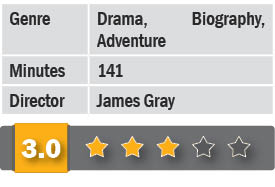 Explorers are a restless, transient tribe of people; they seldom pay heed to reason, relying on their own impulses and acting accordingly. David Grann’s 2009 real-life book (based on his 2005 article on the same and published in the New Yorker magazine) on the explorer Percy Fawcett (Charlie Hunnam) has now been translated onto the big screen by director James Gray.
Explorers are a restless, transient tribe of people; they seldom pay heed to reason, relying on their own impulses and acting accordingly. David Grann’s 2009 real-life book (based on his 2005 article on the same and published in the New Yorker magazine) on the explorer Percy Fawcett (Charlie Hunnam) has now been translated onto the big screen by director James Gray.
A telling story of an intrepid archeologist attempting to change the face of geography – and a slice of history – The Lost City of Z is about the British explorer who is convinced that an ancient city exists in the vast Brazilian jungles, a city whose civilization had unquestionably progressed further than those of the West of those times. The film begins in 1905 with the elite RGS (Royal Geographical Society) directing Major Percy Fawcett who’s stationed in Cork, Ireland to undertake a trip from England to South America to survey the border between Bolivia and Brazil. Fawcett is wryly referred to as one who’s ‘unfortunate with his choice of ancestors’, implying the dishonour brought to the family by his alcoholic father. Percy’s given the opportunity to ‘redeem his family name’.
The film embarks on three expeditions – 1906, 1911 and 1925. Though plodding at times, it’s a well-enacted, well-crafted film of an explorer gamely withstanding the forces of nature – deadly diseases, predators and suspecting natives.
Hunnam, directed by Gray (The Immigrant) gives an outstanding performance as the husband/father fighting his demons – trying to put at rest the gnawing feeling within him of neglecting and abandoning first his pregnant wife Nina (Sienna Miller) and then his son Jack (Tom Holland). The Iranian-French cinematographer Darius Khondji has done a commendable job with the outdoor locations, shot in the relatively safer precincts of the jungles of Columbia.
- Parsee Gym Retains Supremacy In 7th Late Manek Golvala T10 Cricket Cup - 13 April2024
- Parsee Gym Holds 9th All-Parsee TT Tourney - 6 April2024
- Parsee Gym Holds Gala Jamshedi Navroze Celebrations - 30 March2024
